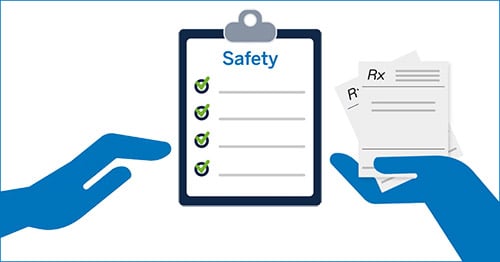Safety Practices for Taking Opioids and Benzodiazepines at the Same Time
If you have surgery at HSS, opioids (also called narcotics) may be part of your short-term pain management plan for several days after your procedure. Some people may also take opioids for longer periods of time to manage chronic pain conditions. Examples of opioid pain medicines include oxycodone (OxyContin, Percocet), hydrocodone (Vicodin, Norco), tramadol (Ultram, Ultracet) and hydromorphone (Dilaudid, Exalgo).

If you already take a benzodiazepine to treat a chronic condition and will need to simultaneously take an opioid for any period of time, you should be aware of important safety information. Taking these medications together can put you at risk.
Benzodiazepines are a type of sedative medication commonly prescribed to treat anxiety or insomnia, but they can also be prescribed to treat panic disorders, seizures, or muscle spasms. Some examples of benzodiazepines include alprazolam (Xanax), clonazepam (Klonopin), diazepam (Valium), and lorazepam (Ativan).
At HSS, we do not generally advise patients to take benzodiazepines and opioids at the same time. However, your doctor may determine that this is the best course of action for your particular situation.
Be sure to accurately report all medications you’re taking so your doctor can advise you and monitor your safety. If you are taking opioids and benzodiazepines at the same time, be sure to learn the steps you can take to reduce your risk.
Why is it risky to take opioids and benzodiazepines at the same time?
Taking opioids and benzodiazepines at the same time may cause heavy drowsiness, slow your breathing, or stop your breathing entirely. This could cause an accidental overdose, which may result in death. Research cited by the National Institutes of Health showed that the overdose death rate in patients taking both medications was 10 times higher than in those only taking opioids.1
Who is at risk of overdose?
There are some common misconceptions people may have about their risk of overdose. People may believe they are not at risk if they follow their prescriber’s instructions, take small doses, are not addicted to or dependent on opioids, or if they have taken these medicines for a long time.
The truth is that anyone taking opioids and benzodiazepines at the same time is at increased risk of overdose. While you should always follow your prescriber’s instructions to reduce your risk, doing so does not mean you have no risk.
Additionally, some medical conditions such as sleep apnea can further increase your risk of complications or accidental overdose.
How can I reduce risk when taking benzodiazepines and opioids at the same time?
Never combine opioids with other substances that can suppress breathing. These substances may include sleep medications, alcohol, marijuana, or other drugs. However, if you commonly use sleep medications or marijuana for a medical condition, do not stop taking them without first talking to your provider. Stopping medicines too quickly can also cause serious problems, including withdrawal symptoms.
Withdrawal symptoms of opioids may include:
- flu-like symptoms, such as sweating, chills or aches
- fatigue, anxiety, or trouble sleeping
- rapid heart rate or headache
- nausea, vomiting, or diarrhea
Withdrawal from benzodiazepines can also cause a variety of symptoms – the most severe may include seizures. You may need to taper off these medications before introducing opioids to treat pain. While taking benzodiazepines alone does not require a referral to HSS Preoperative Pain Screening, if you or your surgeon are concerned, a consult can be placed to review the specifics of each case.
What should I ask my doctor if I need opioids but already take benzodiazepines?
Ask your doctor about the risks and benefits of using these medicines and whether you may temporarily discontinue your benzos while you need to manage pain with opioids.
- Ask your doctor if there are safer medicines to use instead, or if you can slowly reduce your doses.
- Ask about getting naloxone (Narcan, Evzio) in case of emergency.
- If you are having surgery at HSS, your surgeon may recommend that you participate in preoperative pain screening to create a plan.
Video: Opioids and Benzodiazepines – Best Practices for Safety
What is naloxone?
Naloxone, more commonly known by the brand name Narcan, is an opioid antagonist – a medicine used to reverse opioid overdose by countering the effect an opioid has on your brain. It works on opioids, including heroin, fentanyl, and prescribed opioid medicines. It does not work on non-opioid drugs such as benzodiazepines, cocaine, or alcohol. However, naloxone will not hurt someone who is not having an opioid overdose, so you can still administer naloxone if you are not sure what is causing the overdose.
Just as someone with allergies might carry an EpiPen (epinephrine injection device), or someone with diabetes may carry glucagon, naloxone is for emergency use and can save a person’s life.
Video: How to Use Naloxone – Reversing an Opioid Overdose
Where can I get naloxone?
In most states, you don’t need a prescription to get naloxone from a pharmacy. Ask your doctor or pharmacist about getting naloxone.
If you are having surgery at HSS, you can ask about getting a naloxone kit from HSS. HSS is a certified distributor for the NYS Opioid Overdose Program. The chronic pain service has naloxone kits available for patients in the hospital.
